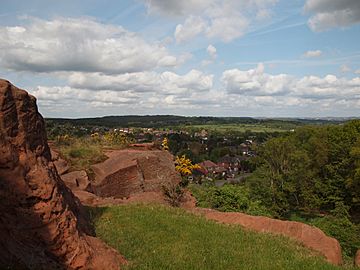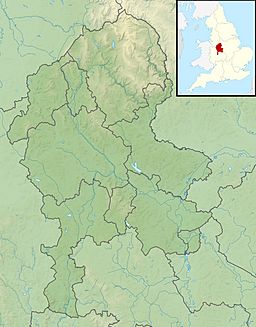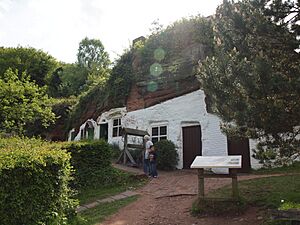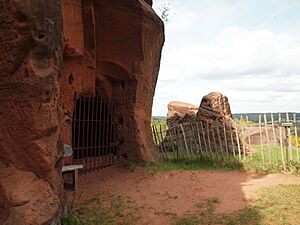Kinver Edge facts for kids
Quick facts for kids Kinver Edge |
|
|---|---|

Kinver as seen from Holy Austin Rock Houses
|
|
| Highest point | |
| Elevation | 164 m (538 ft) |
| Listing | None |
| Geography | |
| Location | Staffordshire, England |
| OS grid | SO829824 |
| Topo map | OS Landranger 102 |
Kinver Edge is a special place in England. It has tall hills covered in heathland and woods. It's located near the towns of Kinver, Stourbridge, and Kidderminster. This area is right on the border of Worcestershire and Staffordshire.
Kinver Edge is famous for its unique cave-houses. These were once homes carved right into the sandstone cliffs. They are the last known cave dwellings in England to have been lived in. Today, Kinver Edge is looked after by the National Trust. They protect important places in England.
Contents
Exploring Kinver Edge: History and Nature
A Look Back: Ancient Forts and Early Visitors
Kinver Edge was once part of a huge ancient forest. Even though many trees were planted after 1945, it still feels very old. You can find two Iron Age hillforts here. These were ancient settlements built on high ground for protection. The larger fort is at the northern end of Kinver Edge. The other is at the southern end, on a spot called Drakelow Hill.
People have enjoyed visiting Kinver Edge for a long time. It became a popular tourist spot in the Edwardian era. Back then, an electric tramway, the Kinver Light Railway, connected Kinver to the tram system in Birmingham. This made it easy for people to visit.
How Kinver Edge Became a National Trust Site
The National Trust helps protect beautiful and historic places. In 1917, they were given 198 acres of Kinver Edge. This gift came from the children of Thomas Grosvenor Lee. He was a lawyer from Birmingham who was born in Kinver. The land was given in memory of him and his wife.
Later, the National Trust bought more land. They added another 85 acres between 1964 and 1980. In 2014, a nearby area called Kingsford Forest Park joined Kinver Edge. This park was about 200 acres and was also in Worcestershire. By 2018, signs for Kingsford Forest Park were replaced with National Trust Kinver Edge signs. Now, the total area of Kinver Edge is about 600 acres.
The Amazing Rock Houses
Kinver Edge is home to the last troglodyte dwellings in England. These are complete cave-houses carved into the soft sandstone. One famous group of these is called the Holy Austin rock houses. They were lived in until the 1960s. Before that, one of the rocks, Holy Austin, was a quiet place for a hermit.
Today, the National Trust owns these rock houses. You can visit them and take a tour. One house has been made to look like it did in Victorian times. The Martindale Caves show what life was like in the 1930s. The gardens around the cottages and an orchard are also being replanted and restored.
Other Cave Dwellings to Discover
There are other interesting cave dwellings at Kinver Edge:
- Nanny's Rock: This is a large cave with five sections. It seems it was never turned into a full house. For many years, it was known as 'Meg-o-Fox-Hole'. Records show that someone named 'Margaret of the fox earth' died in 1617. She might have lived there.
- Vale's Rock: Also called Crow's Rock, this cave was later made into a two-level house. People lived here until the 1960s. However, it is now fenced off because it is not safe for visitors.
Geography and Landscape
Kinver Edge is located east of the Severn Valley. It is in the South Staffordshire and Wyre Forest Districts. This area is part of the green belt, which means it is protected from too much building. It sits right on the edge of the urban West Midlands area.
The highest point of Kinver Edge is 164 metres (538 feet) above sea level. From the top, you can see amazing views. You can spot the Clent Hills, Shatterford Hill, and even the distant Malvern Hills and Shropshire Hills. The Edge is a ridge made of sandstone. It has rounded pebbles on top and can be affected by natural wear and tear.
Wildlife and Plants
Habitats and Trees
Kinver Edge has two main areas of heathland. Heathland is open land with small shrubs and grasses. The larger heathland is near the top of the northern part of the Edge. The smaller one is in the southern part, which used to be Kingsford Forest Park.
The northern part of the woodland has broadleaf trees like birch, oak, and sweet chestnut. The former Forest Park mostly has coniferous trees, which are often planted in rows. The National Trust is working to bring back more heathland. They plan to restore about 47.9 acres of heathland in the former Forest Park over the next 10 years.
Animals of Kinver Edge
The heathland at Kinver Edge is home to many different animals. You might see adders (a type of snake) and common lizards. Heathland birds like the skylark also live here.
In the woods, you can find many other bird species. These include the common buzzard, Eurasian jay, and great spotted woodpecker. Mammals like the badger and red fox also make their homes in the woods. Sometimes, longhorn cattle are allowed to graze on the heathland. This helps to keep the plants healthy.
What People Do at Kinver Edge Today
Kinver Edge is mainly used for tourism and managing the natural area. It's a great place for outdoor activities. The Staffordshire Way, a long-distance walking path, goes right over the summit. The North Worcestershire Path runs through the area that used to be Kingsford Forest Park. This part of Kinver Edge is also popular for mountain biking.





